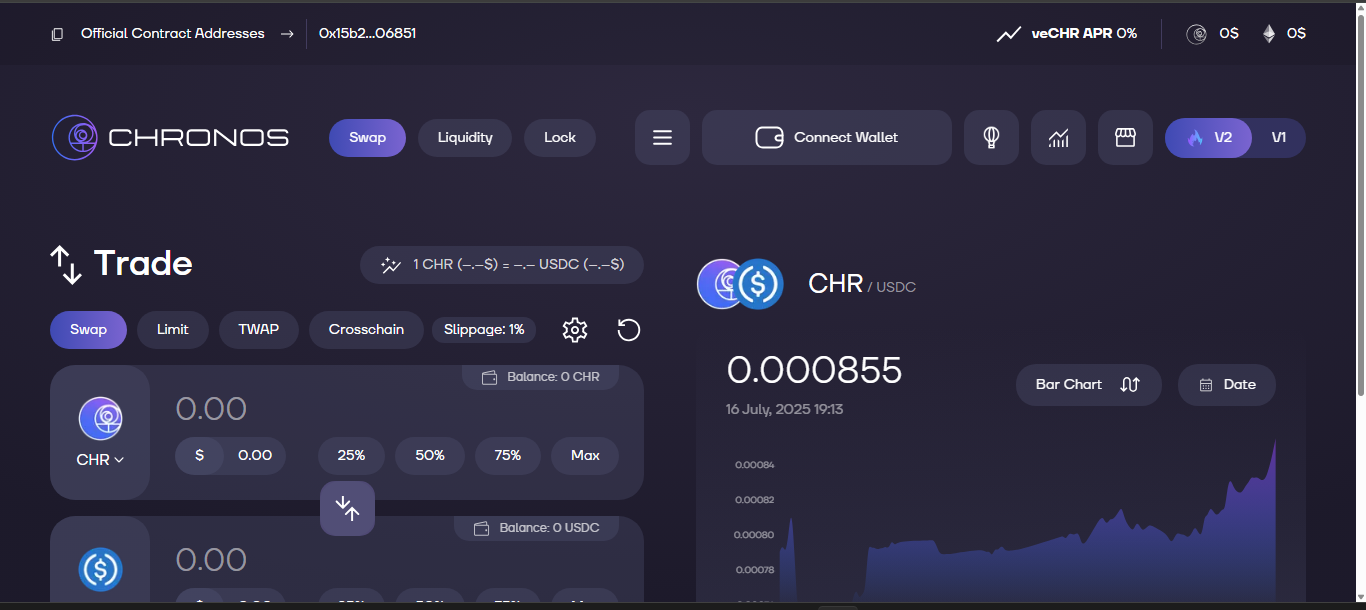Chronos Exchange - DeFi protocol with ambitions, liquidity still in its infancy

Chronos Exchange launched in late 2021 on Arbitrum with the goal of offering zero‑fee spot and perpetual trading backed by protocol revenue sharing. It aimed to mix on‑chain primitives, community governance and aggressive incentives to rival centralized exchanges. But years in, liquidity remains light, utility is emerging slowly, and it’s still a niche experiment rather than a full‑blown marketplace.
Early design and token model
Chronos branded itself as a permissionless decentralized exchange with futures, lending and perpetual markets all on Arbitrum. Its native token, CHR, plays a dual role:
- Fee sharing: CHR holders receive a portion of exchange income
- Governance power: Holders vote on risk‑parameters, listing and strategy
The emission schedule was front‑loaded, handing out CHR via an airdrop to Arbitrum users, farmers and referrers. Vesting schedules and the vest‑to‑stake model pushed users to provide liquidity in return for protocol ownership and revenue streams.
How populated are the markets?
Volume and depth remain limited:
- Spot trading only totals a few hundred thousand dollars per day
- Perpetual volumes hover at a similar level
- Order book depth is thin – typical spread slippage exceeds 0.5 percent on moderate trade size
That’s low compared to leading DEXs or centralized exchanges. It means traders may find moving larger orders difficult and suffer poor price execution. For passive users, revenue from yield or staking may offer more value than active trading.
Utility vs complexity
The Chronos interface lets users swap tokens, open perpetuals, deposit into lending pools and stake CHR for revenue share. That’s a broad feature set for an on‑chain app.
- Perpetuals support up to 50x leverage
- Lending pools offer variable APY depending on utilization
- Staked CHR earns a share of net trading fee revenues
However, deploying these requires interacting with multiple smart contracts. Gas fees on Arbitrum, though lower than Ethereum mainnet, add friction. And limited liquidity means yield is modest once early incentives fade.
Token behavior and distribution
CHR’s initial supply was large and widely distributed through incentives. However:
- A significant portion remains unlocked or in the hands of early insiders
- Token price is volatile, frequently swinging by 20 to 50 percent in a single day
- Real utility depends on CHR being staked to earn yield, reducing circulating supply - yet many holders still hold unlocked tokens ready to sell
Without strong staking momentum, token value remains speculative and tied largely to incentive programs rather than organic demand.
Security and code assurance
Chronos relies on smart contract architecture. Key security checkpoints:
- Multiple audits were carried out in 2022 and 2023
- Bug bounty programs issued small grants
- Open‑source contract code invites third‑party review
Still, no guarantee exists against novel DeFi exploits or oracle manipulation. Audits sorted earlier issues, but future attacks remain possible, especially with small liquidity pools making manipulation cheaper.
User base and community tone
Growth has been organic but limited. On‑chain metrics show only a few hundred daily active wallet addresses. Discord and Telegram activity are moderate, driven mainly by updates and CHR staking boosts rather than strong trading action.
Feedback is mostly from early adopters praising the protocol idea and roadmap. Yet many also caution that experience remains beta‑like - usability rough around the edges, UI cluttered, and key features still under development. No tales of lost funds, but that may simply be due to low usage.
Pros & cons at a glance
Feedback across forums and reviews is diverse:
Strengths
- Permission‑free trading with revenue sharing and governance for CHR holders
- Integration of spot, perpetuals and lending in one protocol
- Smart contract audits and bounty support
- Early‑stage experiment with future potential
Weaknesses
- Insufficient trading volume and shallow markets
- High token inflation and volatility tied to incentive programs
- Complexity of multi‑contract navigation and gas costs
- Protocol still in development, may surprise users
Final take - experimental DeFi hub, not a trading powerhouse
Chronos Exchange presents an intriguing DeFi model: decentralized futures, spot, lending and governance all bundled with token incentives. That’s ambitious and could serve as a foundation for a decentralized financial ecosystem.
But today, it's still more concept than reality. With thin liquidity, volatility-driven token economics and ongoing development, it’s best approached as an experiment or speculation portal. Traders seeking serious volume, deep order books or fiat on‑ramps should look elsewhere.
If you want to explore early‑stage DeFi innovation, stake CHR to earn yields or simply watch how decentralized futures develop, Chronos offers a taste. Just don’t expect it to replace mainstream exchanges. It’s proof of concept rather than polished product.
Disclaimer
“This content is for informational purposes only and does not constitute financial advice. Please do your own research before investing.”
.png)







%203.svg)
%203.svg)




















